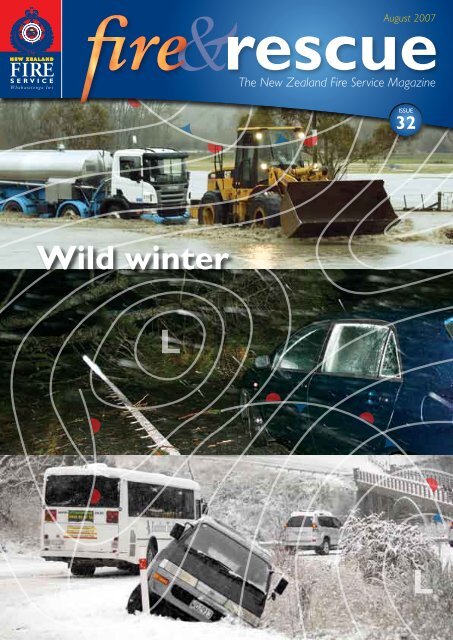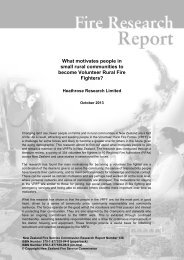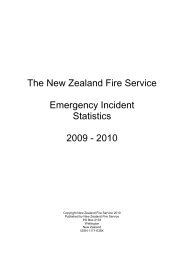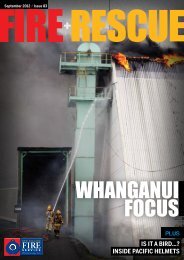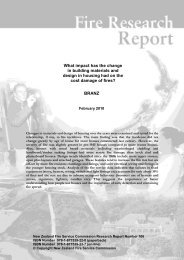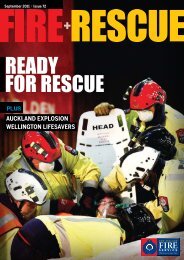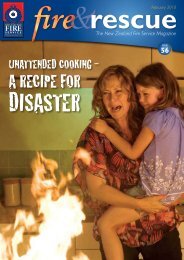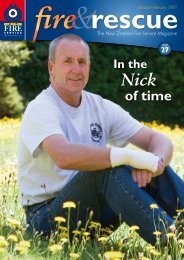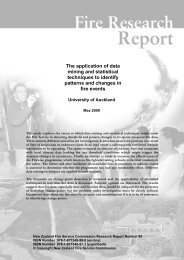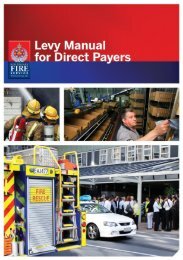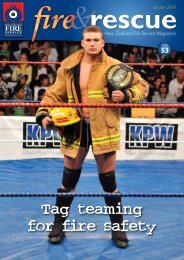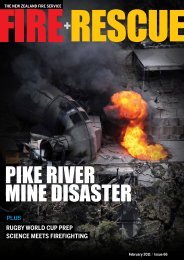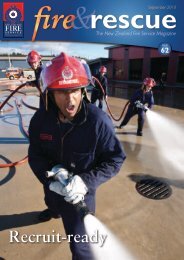Download PDF: Issue 32 - New Zealand Fire Service
Download PDF: Issue 32 - New Zealand Fire Service
Download PDF: Issue 32 - New Zealand Fire Service
You also want an ePaper? Increase the reach of your titles
YUMPU automatically turns print PDFs into web optimized ePapers that Google loves.
Wild winter<br />
L<br />
August 2007<br />
The <strong>New</strong> <strong>Zealand</strong> <strong>Fire</strong> <strong>Service</strong> Magazine<br />
ISSUE<br />
<strong>32</strong><br />
L
<strong>Fire</strong> & Rescue is the flagship<br />
publication of the <strong>New</strong> <strong>Zealand</strong><br />
<strong>Fire</strong> <strong>Service</strong>.<br />
August 07<br />
<strong>Issue</strong> No. <strong>32</strong><br />
It is produced by Media,<br />
Promotions and Communications,<br />
National Headquarters,<br />
Level 9, 80 The Terrace, Wellington.<br />
Front cover: Top Pic: A milk tanker<br />
is towed through the flood waters<br />
covering the road at the intersection<br />
to Maraekakaho, near Napier.<br />
Middle Pic: A huge fallen tree<br />
completely blocks State Highway<br />
One just north of Waipu (south of<br />
Whangarei). Bottom Pic: Heavy snows<br />
cause chaos on Queenstown roads.<br />
Back cover: <strong>Fire</strong>fighters dampen<br />
down a fire in an abandoned<br />
house in Martin Square,<br />
central Wellington, <strong>New</strong><br />
<strong>Zealand</strong>, Sunday,<br />
29 July 2007.<br />
We welcome contributions from<br />
<strong>Fire</strong> <strong>Service</strong> personnel and their families.<br />
Email stories and digital pictures to:<br />
fire.rescue@fire.org.nz<br />
(Pictures need to be at least 1MB)<br />
Post written material and celluloid<br />
photos, or photo CDs to:<br />
<strong>Fire</strong> & Rescue magazine,<br />
PO Box 2133, Wellington.<br />
(These will be returned on request)<br />
If you just have an idea or have an<br />
upcoming event you would like<br />
<strong>Fire</strong> & Rescue to cover, call<br />
the editor on (04) 496 3675.<br />
<strong>Fire</strong> & Rescue is online at:<br />
www.fire.org.nz<br />
ISSN: 1176-6670<br />
All material in <strong>Fire</strong> & Rescue magazine is<br />
copyrighted and may not be reproduced<br />
without the permission of the editor.<br />
4<br />
8 11<br />
The <strong>Issue</strong> Marae fire safety initiative..............................................................3<br />
Cover Story Nature’s beast .......................................................................................4<br />
Aiding and Abetting Remote control floods .......................................................................8<br />
Training Turning on the TAPS ............................................................................9<br />
Obituary Gerald Hugh Geddes, QSM ........................................................10<br />
Incidents The prevention work we do does make a difference ..11<br />
Demolition derby ...............................................................................12<br />
Truck ’n’ roll ............................................................................................13<br />
Shiver me timbers .............................................................................14<br />
Truck stop .............................................................................................15<br />
Profile The torch burns bright ...................................................................16<br />
Fun & Games Seconds out ..........................................................................................17<br />
Open day ..............................................................................................18<br />
Awards Brothers in arms ................................................................................20<br />
In the Community These guy are firewise ...................................................................21<br />
Tales from Afar Talking Turkey ......................................................................................22<br />
Noticeboard Notes and events .............................................................................23<br />
16 18 20
Marae fire safety initiative<br />
A Marae <strong>Fire</strong> Safety Initiative was launched at Heretaunga Taiwhenua in Hastings during July.<br />
The concept was initiated by Hastings firefighters Hanna<br />
Wainohu and Jamie Keenan, supported by our region<br />
Ma - ori Liaison officer, Lana Ngawhika, and <strong>Fire</strong> Safety<br />
Officer, Mike Finucane.<br />
The initiative involves working with Te Puni Kokiri to<br />
convene hui (meetings) with Ngati Kahungunu hapu -<br />
(sub-tribes) in order to deliver Marae <strong>Fire</strong> Safety<br />
recommendations and advice. Te Puni Kokiri is a<br />
government agency set up to assist with economic and<br />
resource development for Ma - ori and to specifically assist<br />
crown agencies to work with Ma - ori.<br />
“Although this concept was already in our minds, the<br />
tragic loss of whare tupuna (ancestral meeting houses) at<br />
Te Huki Marae in Raupunga really kick-started the<br />
initiative” explains Lana. She noted that pulling the initial<br />
meeting of stakeholders together was easily achieved<br />
through the existing connections of firefighters Wainohu<br />
and Keenan. “Both Hanna and Jamie are ‘tangata<br />
whenua’, and knew who needed to be involved with the<br />
project to get it underway.”<br />
Roger Aranui, Regional Director of the Takitimu office of<br />
Te Puni Kokiri, arranged for invitations to be sent to<br />
over 30 marae affiliated with the Heretaunga Taiwhenau<br />
– and despite a number of recent tangihanga (funerals)<br />
and other commitments, the marae representatives<br />
arrived in numbers.<br />
<strong>Fire</strong> damage to the Raupunga Marae.<br />
The <strong>Issue</strong><br />
Gisborne CFO Charlie Turei makes his point clear.<br />
Photo Kerry Marshall<br />
“We were able to share with the marae members critical<br />
information necessary to keep their people, whare<br />
(buildings) and taonga (treasured belongings) safe from<br />
the destruction of fire”, Lana advised. “In addition, we<br />
have offered the services of our <strong>Fire</strong> Safety Officers to<br />
visit individual marae and provide specific advice<br />
including interim safety measures, and have already<br />
received inquiries regarding this service. We also arranged<br />
for funding providers, such as the Department of Internal<br />
Affairs, to be present as key speakers,<br />
to advise of the funding opportunities<br />
available to assist marae with the<br />
installation of fire protection systems”.<br />
Lana explains that this initiative will<br />
continue throughout the rohe (tribal<br />
boundaries) of Ngati Kahungunu,<br />
with meetings planned to be held<br />
with Kahungunu ki Wairarapa, and<br />
Kahungunu ki Wairoa in the near<br />
future. “From there, we intend to<br />
work with our Gisborne staff to<br />
deliver these messages throughout<br />
Turanga and along the East coast.<br />
There are over 200 marae scattered<br />
throughout the Eastern <strong>Fire</strong> Region,<br />
and our aim is to make contact<br />
with them all”.<br />
The <strong>New</strong> <strong>Zealand</strong> <strong>Fire</strong> <strong>Service</strong> Magazine August 2007 3
Nature’s b<br />
Taranaki became Kansas, Northland and Hawke’s Bay suffer a deluge and the South Island was,<br />
well it was the South Island. Welcome to winter in <strong>New</strong> <strong>Zealand</strong> 2007 version – 4 different<br />
centres, 3 different weather extremes, 2 weeks of hell, 1 wordy article.<br />
C’mon baby, let’s do the twist…<br />
On July 4 a tornado ripped through <strong>New</strong><br />
Plymouth removing the roof of the local<br />
Placemakers store and with little regard for safety<br />
flicked it across the road. With an estimated $1.5<br />
million damage done, it was believed that it was<br />
over. Sadly for the residents of Taranaki it wasn’t.<br />
That lone tornado was just the opener in a night<br />
of howling winds, fierce storm clouds and “huge<br />
black triangles.”<br />
July 4 and 5 saw several tornadoes tear through<br />
Taranaki with widespread damage but thankfully,<br />
no fatalities.<br />
The first tornado struck early afternoon on<br />
Wednesday; Placemakers on Molesworth Street<br />
was the worst hit. The sprinkler alarm system<br />
sounded at 1pm, alerting the local fire station.<br />
<strong>New</strong> Plymouth SSO Trevor Moore was one of<br />
the first on the scene. “When we arrived, clearly<br />
there had been significant building damage and<br />
the sprinkler system had been carried away by<br />
the roof,” he told NZPA. <strong>New</strong> Plymouth CFO<br />
Pat Fitzell said it was a miracle no one had been<br />
badly hurt. “Had it gone metres either side [of its<br />
path] there would have been total destruction.”<br />
But this was minor compared to what was<br />
in store for the following 24 hours.<br />
Starting around 6pm that night, at least six tornadoes<br />
struck the wider Taranaki region leaving<br />
a 140km trail of destruction. The worst was saved for the<br />
coastal township of Oakura, where multiple houses have<br />
been rendered uninhabitable. Fitzell was driving out<br />
towards Oakura as “it was pouring with rain, then<br />
suddenly it became really light, then total darkness,<br />
it was quite eerie.”<br />
But damage was not confined to just coastal Taranaki; a<br />
number of Stratford towns were damaged when a tornado<br />
charged through town in the middle of a thunderstorm.<br />
A state of emergency was declared in Taranaki on July 5<br />
after 7,000 homes across the region lost power, and large<br />
numbers became homeless. Taranaki emergency<br />
4 <strong>Issue</strong> No. <strong>32</strong><br />
Cover Story<br />
e<br />
a s<br />
t<br />
management controller David Lean told the Taranaki<br />
Daily <strong>New</strong>s that he’d been involved with Civil Defence<br />
for over 20 years “and I’ve never seen anything like this.”<br />
July 6 saw the emergency level lifted as power was<br />
returned to all but a few hundred people. This was largely<br />
due to the “incredible” community spirit. Fitzell had<br />
people turning up with “hammers, a chainsaw, a few<br />
nails. One woman turned up and told me she had<br />
a hammer in her boot and that she could use it”.<br />
Bob McDavitt, a Met<strong>Service</strong> Weather Ambassador<br />
commented to <strong>Fire</strong> & Rescue that he’d “been forecasting<br />
for 35 years now and I cannot remember so many<br />
[tornadoes] coming from one front”. He said basically, a
School’s out for winter<br />
Mother Nature was still not finished. On July 17,<br />
two Hawke’s Bay schools were forced to shut their<br />
doors and the army called in to evacuate students as<br />
heavy rain over night, and all through the morning,<br />
caused surprise flooding.<br />
Unimogs were called to rescue students stranded by the<br />
floodwaters at Puketapu and Maraekakaho schools.<br />
The Hastings Civil Defence team provided portable<br />
toilets as septic tank issues added to the woes already<br />
experienced. The area’s Civil Defence controller told<br />
NZPA that he had received “tremendous”<br />
assistance from the<br />
<strong>New</strong> <strong>Zealand</strong> <strong>Fire</strong><br />
<strong>Service</strong>, the Army, the<br />
Police, Red Cross and<br />
the Salvation Army.<br />
Ironically, Waterworld<br />
swimming complex in<br />
Flaxmere was shut<br />
due to the conditions,<br />
as was the library and<br />
community centre.<br />
Two bridges on State<br />
Highway 50 linking<br />
Napier to Takapau were<br />
submerged as some places<br />
lay under more than<br />
a metre of water.<br />
The Kaitake Kindergarten in Oakura<br />
suffered massive damage from the twisters.<br />
tornado is when “there’s a huge clash of air masses and<br />
they are fighting to even out their differences.”<br />
From the damage reports given, McDavitt believes the<br />
tornadoes were F0 and F1 on the Fujita Scale, a rating<br />
system used to describe the<br />
damage done by a particular<br />
tornado. The scale goes from F0 – F5,<br />
where F5 means houses are lifted off<br />
foundations and carried some distance.<br />
“However, <strong>New</strong> <strong>Zealand</strong> thunderstorms<br />
are usually mediocre, around F0 or F1, though<br />
there was an F3 that took two lives in<br />
Waitara in 2004”.<br />
Pat Fitzell attended the callout to that Waitara<br />
disaster, and now with two sets of tornado<br />
emergencies under his belt, commented that<br />
tornadoes are unlike any other call outs<br />
“During tornadoes, things are picked up and<br />
scattered over a big distance. On Thursday<br />
night, they just came out of nowhere and there were tops<br />
of houses being ripped out and strewn across the village<br />
and into other structures. Some people only got seconds,<br />
one guy looked up, saw it coming and dived into a<br />
wardrobe, then the whole top of his house got torn off”.<br />
A milk tanker is towed through the flood<br />
waters covering the road at the intersection<br />
to Maraekakaho, near Napier, <strong>New</strong> <strong>Zealand</strong>,<br />
Tuesday, July 17, 2007.<br />
Cover Story<br />
<strong>Fire</strong> and rescue teams set up shop<br />
at a woolshed in the Hawke’s Bay.<br />
The <strong>New</strong> <strong>Zealand</strong> <strong>Fire</strong> <strong>Service</strong> Magazine August 2007<br />
5
Kaeo KO’D<br />
For the second time in four months Northland suffered<br />
extreme rainfall and flooding. Over 250mm of rain fell in<br />
just one 24-hour period (July 10/11) isolating Kaeo from<br />
the rest of the region and sending the far north into a<br />
state of emergency. Auckland was battered by winds of<br />
up to 180km/h and floodwaters were up to a metre high<br />
in places. Whilst parts of the Coromandel fell victim to<br />
the foul weather also.<br />
Northland was the worst hit, with large parts plunged<br />
into darkness due to line-falls. Linesmen worked on in<br />
hellish conditions to restore power but it was a number of<br />
days before those in the more remote parts had their<br />
electricity switched back on. At the peak of the storm,<br />
there were 141,000 people without power.<br />
A state of emergency was declared on Tuesday July 10<br />
but lifted again on July 13, as council services switched<br />
from emergency management to clean up mode.<br />
EIRSA member Karl Baker said it was far worse than the<br />
March floods, the EIRSA team worked around the clock<br />
from the CD bunker in Wellington (see our profile of Karl’s<br />
work in this issue). “204 maps were generated over the<br />
flooding period, this was four times as many as usual”.<br />
Prime Minister Clark, Civil Defence Minister Rick Barker<br />
and list MP Dover Samuels all took in the damage done,<br />
the Prime Minister even went so far as to suggest that<br />
some of the places that are starting to suffer on a semiregular<br />
basis may have to consider up and leaving.<br />
A huge fallen tree completely blocks<br />
State Highway One just north of Waipu<br />
(south of Whangarei) during stormy<br />
weather in Northland during July.<br />
6 <strong>Issue</strong> No. <strong>32</strong><br />
Cover Story<br />
Farmer Jan Beatty looks to rescue two<br />
stranded cows on her swamped farm<br />
in Tangiteroria in Northland during July.<br />
Kaeo volunteer chief Lindsay Mitchell had to endure<br />
water creeping into the station for the first time in the<br />
station’s 26-year history. “We were fairly hamstrung<br />
anyway, there’s only two ways in and out of Kaeo, one<br />
goes north, the other goes south, both were blocked, I<br />
hadn’t seen it like that before.<br />
“The response has been great, and not just from our<br />
community either, all round the country. A group from<br />
Methven and from Mt Summers sent up some home<br />
baking, a huge thing of biscuits. I know I wouldn’t trust<br />
my cooking to send down to Methven!”.<br />
As of July 23, Lindsay said that it was back to business as<br />
usual though “the <strong>Fire</strong> Station hasn’t got any carpet at<br />
the moment, we had to chuck it out.”
South Island stays par for the course!<br />
In the South Island, it has remained relatively calm.<br />
There have been some very chilly temperatures, with<br />
recorded lows of –7 o but, as Chief of Alexandra Volunteer<br />
Station Russell Anderson noted “Most people don’t really<br />
want to be outside to be honest”.<br />
The far south has been coated in frosts with some areas<br />
hit harder than most. As our photos show, Mother Nature<br />
can be cruel but beautiful. The Alexandra vehicle testing<br />
station gained an indoor swimming pool when a fire reel<br />
burst flooding the office and then the pit.<br />
Cover Story<br />
<strong>Fire</strong> & Rescue roving photographer,<br />
volunteer support officer Mark Hutton<br />
took some stunning shots of the frosts and<br />
sent them in. Whilst cold and somewhat<br />
frozen over, Mark mentioned that it was<br />
“mostly business as usual”.<br />
Heavy snows cause chaos on<br />
Queenstown roads, Queenstown,<br />
<strong>New</strong> <strong>Zealand</strong>, Thursday, June 21, 2007.<br />
The <strong>New</strong> <strong>Zealand</strong> <strong>Fire</strong> <strong>Service</strong> Magazine August 2007<br />
7
Picture this: it’s one of the most important moments<br />
of your life, the birth of your child. The big day arrives and the<br />
world greets Rhys, your new born son.<br />
Remote control floods<br />
8 <strong>Issue</strong> No. <strong>32</strong><br />
Aiding and Abetting<br />
One week later and work calls.<br />
There’s been some flooding in a far<br />
off town, but because of your<br />
technical know-how you’re needed in<br />
the Civil Defence Emergency Bunker.<br />
This was Karl Baker’s reality the<br />
week of the Northland Floods.<br />
As water levels rose there was a<br />
sudden need for emergency data<br />
analysts. “A report would come in<br />
and a map would need to be generated<br />
in 15 minutes, we’ve never had such<br />
tight deadlines before” said Karl. The<br />
maps would show closed roads,<br />
where evacuation centres were<br />
located and where there were places<br />
without power or phone connection.<br />
Throughout Northland, in and<br />
around Auckland and as far out as<br />
the Coromandel Peninsula, homes<br />
were without power, people were<br />
stranded from aid and emergency<br />
evacuation centres were springing up.<br />
Rescue teams throughout needed to<br />
be in the know.<br />
Malcolm MacFarlane,<br />
manager of Data and<br />
Application Support,<br />
had been advised<br />
that “things were<br />
happening” and the<br />
team moved to the<br />
b u n k e r o n t h e<br />
afternoon of the<br />
10th of July.<br />
For the next 48<br />
hours the bunker<br />
was manned around<br />
the clock, then<br />
worked in shifts<br />
until Sunday. The <strong>Fire</strong><br />
<strong>Service</strong> fulfill a dual roll inside the<br />
centre – co-operating with Ministry<br />
of Civil Defence staff and mapping<br />
support for all agencies.<br />
“When that call comes in, you head<br />
to HQ, grab a disaster kit and make<br />
your move” explained Malcolm. The<br />
disaster kits include a backup of data<br />
found on HQ’s network meaning that<br />
The local rugby club playing fields in Kaeo<br />
are underwater after storms in the Far North,<br />
<strong>New</strong> <strong>Zealand</strong>, Wednesday July 11, 2007.<br />
Malcolm MacFarlane (left) and Karl Baker<br />
anxiously check maps of the Northland Region.<br />
in the event of “Armageddon” the<br />
bunker still has access. For the first<br />
time, references for planning flight<br />
paths for helicopter reconnaissance<br />
were also provided and power and<br />
telecommunication status maps were<br />
supplied to the owners of the<br />
infrastructure.<br />
The system relied on input from in<br />
and around the regions affected, Karl<br />
explained that it was thanks to those<br />
“who emailed us and told us where<br />
there were places without power, and<br />
which areas had phone lines down –<br />
not even Telecom had that<br />
information”.<br />
On the Coromandel Peninsula,<br />
Powerco had 26,000 customers<br />
without power; aided by the <strong>Fire</strong><br />
<strong>Service</strong> they were able to find out<br />
where those people were, get to them<br />
and bring them back online. Telecom<br />
did the same. Malcolm says it’s the<br />
unique tools the <strong>Fire</strong> <strong>Service</strong> has at its<br />
disposal that sees it so in demand in a<br />
crisis situation.
It’s been in the making for a while,<br />
and it’s just hit that finish line. Now<br />
the TAPS programme will be rolled out<br />
nationwide and career firefighters will<br />
benefit greatly.<br />
Just what TAPS is, is best left defined by the brochure<br />
being distributed to every career fire-fighter in the country:<br />
“The <strong>Fire</strong> <strong>Service</strong> Training and Progression System (TAPS)<br />
for career fire-fighters is, as the name suggests, a system<br />
governing the career progression of every fire-fighter<br />
through the ranks, from the newest recruits to chief fire<br />
officers and beyond”.<br />
As soon as someone is recruited as a career fire-fighter<br />
they are started in the TAPS course with an eleven week<br />
recruitment programme before starting up the ladder with<br />
the Qualified <strong>Fire</strong>fighter (QFF) programme.<br />
TAPS is being championed by Brendan Nally, the<br />
implementation coordinator, Brendan told <strong>Fire</strong> & Rescue<br />
“the old system was a bit archaic, it was attendance based<br />
and then exams, but with TAPS, there’s a structure in<br />
place to support those taking part.” For example, if you<br />
fail any of the assessments, then there’s a re-assessment<br />
but there’s also remedial training in place to help. “That’s<br />
a fairly big thing, the old way of doing it didn’t have that<br />
learning support.”<br />
The system has been in the making for six years, in that<br />
time programme trainers have been qualified and assigned,<br />
markers prepared and a rigorous set of training programmes<br />
and learning modules drawn up. “The other new part”<br />
said Brendan “is that TAPS is an NZQA accredited system,<br />
so firefighters can apply what they gain with us, outside of<br />
the fire service, something unheard of previously”.<br />
Some elements of TAPS have been running prior to the<br />
national rollout; for example, the career recruitment<br />
programme is part of the TAPS course as well as some of<br />
the practical exercises in the SO programme so when<br />
roll-out occurs it will not be a complete wipe-out of the<br />
old, Brendan still sees some challenges ahead though.<br />
“The biggest difficulty we face will be getting the<br />
information out there so everyone understands, that’s<br />
why we released the brochure, and that’s why we’re<br />
using other media to get people in the know”.<br />
Training<br />
Turning on the TAPS<br />
TAPS<br />
TRAINING AND PROGRESSION SYSTEM<br />
At the moment there is limited information available on<br />
<strong>Fire</strong>net, under Training on the side-panel, then TAPS<br />
there is a Frequently Asked Questions page and a section<br />
on Student Guides and Support.<br />
On 6 August this year, the collective agreement was<br />
ratified, meaning it’s now time to tap into the good stuff.<br />
The <strong>New</strong> <strong>Zealand</strong> <strong>Fire</strong> <strong>Service</strong> Magazine August 2007<br />
9
10 <strong>Issue</strong> No. <strong>32</strong><br />
Obituary<br />
5/2/1931 – 17/7/2007<br />
Gerald Hugh Geddes, QSM<br />
On Tuesday, July 17, operational support officer Gerald Geddes collapsed during a PFA call to the<br />
Lawrence Hospital and was air lifted to Dunedin Hospital where he died in the early hours of<br />
Thursday morning.<br />
Gerald will be remembered as the backbone of the<br />
Lawrence Volunteer <strong>Fire</strong> Brigade and a pillar within the<br />
Lawrence community where he was involved with many<br />
organisations at various levels.<br />
Gerald’s involvement with the brigade totalled 52 years;<br />
including 26 years as Chief <strong>Fire</strong> Officer. His role was<br />
extended to assist neighbouring Waitahuna Brigade,<br />
serving as their CFO for 21 years until his operational<br />
retirement in 1997 when he continued his new role within<br />
operational support. During his volunteer career, Gerald<br />
was given life honourary membership and was awarded<br />
the Double Gold Star in 2005.<br />
Outside of the fire department, Gerald worked for the<br />
Lawrence School Committee between 1968-1984 as<br />
treasurer as well as chairman for 2 terms. He worked<br />
tirelessly for the local borough council between 1971-<br />
1989, served 2 terms as Deputy Mayor; and was the last<br />
Mayor in Lawrence prior to amalgamation with the<br />
Clutha District. Gerald was one of the first drivers for<br />
the St Johns Ambulance <strong>Service</strong> and was President of<br />
their Association in 1958.<br />
He was a Jaycees’ member from 1961 till 1973<br />
and was made a senator in 1970. Gerald was an<br />
inaugurated member of the Lions Club and<br />
was president 1972-1973, zone chairman<br />
1975-1976 and received the Honoured<br />
Membership Award in 1992; in 1994 he was<br />
honoured with the Melvin Jones Fellow<br />
Award for dedicated Humanitarian <strong>Service</strong>s<br />
from the Lions Club International.<br />
Gerald’s other passions were the Vintage<br />
Club, Simpson Park, working as a board<br />
member at the Lawrence Hospital and<br />
he frequently helped with the Local<br />
information centre. Gerald was also a<br />
Justice of the Peace.<br />
During his funeral service, Gerald’s family,<br />
friends and colleagues spoke of his<br />
achievements and love for family and of<br />
his committed approach to all the clubs<br />
and associations with which Gerald was<br />
affiliated with.<br />
<strong>Fire</strong> Fighters throughout <strong>New</strong> <strong>Zealand</strong> who knew<br />
Gerald will be deeply affected by his sudden death<br />
and we are all thinking of his wife Kath, children<br />
David, Peter and Dallas, Pam and Wayne, Debbie and<br />
Bruce, all grandchildren and wider family. We feel blessed<br />
we could all be a part of Gerald’s life and salute him as a<br />
legend within the district.<br />
Rory Tisdall<br />
CFO Lawrence Volunteer <strong>Fire</strong> Brigade
Photo courtesy of Northern <strong>New</strong>s<br />
In November 2005, the Kaikohe <strong>New</strong> World was razed to<br />
the ground by fire. This rammed home the importance of<br />
fire safety to the manager, Bernie McGinty. Having<br />
witnessed the devastation the fire left, he did not want to<br />
see this happen elsewhere in the community.<br />
Almost a year to the day later, the Kaikohe <strong>New</strong> World<br />
rose from the ashes and was re-opened with all the<br />
expected pomp and ceremony. Part of the opening<br />
celebration saw the Kaikohe brigade spend several days<br />
in-store promoting escape plans, home sprinklers, and<br />
smoke alarms. The supermarket provided some smoke<br />
alarms for giveaway.<br />
A young mother was given 4 alarms for her rental property<br />
in rural Omanaia and installed them just prior to Christmas.<br />
On 10 January 2007 this year at 11.30, the alarms<br />
activated, alerting the family to a developing fire.<br />
The family all escaped; unfortunately, a combination of<br />
the speed of the fire, the brigade travel distance and<br />
meagre water supplies, the house could not be saved.<br />
Incidents<br />
The prevention work we do<br />
does make a difference<br />
Sometimes there are grumbles around the place as to the level of fire safety promotion<br />
we have to do, but then we hear that fire safety activity has directly resulted in saving<br />
lives and it becomes clear why we do it.<br />
Bernie McGinty did not need to have the fire brigade in<br />
his store. He could have utilised the space during opening<br />
week for a more profitable venture. Instead he knew the<br />
importance of promoting fire safety and passed that<br />
information on to customers as they took advantage of<br />
the opening week’s specials.<br />
All the promotion needed, was staff with static display<br />
material, good advice, and a cheery disposition. It was<br />
simple, involved minimal brigade staff, but was clearly<br />
very effective.<br />
Kaikohe CFO Bill Hutchinson is a proud supporter of fire<br />
safety within his fire district. He encourages all members<br />
to do their bit, whether at their workplace, home, or even<br />
socially. <strong>Fire</strong> prevention activity is just as important as the<br />
big red trucks.<br />
Maybe this kind of attitude filtering from the Chief<br />
through the ranks is why the Kaikohe <strong>Fire</strong> Brigade won<br />
the National Commanders Station of the Year Award<br />
a couple of years back.<br />
The burnt out remains<br />
of the house in Omanaia.<br />
The <strong>New</strong> <strong>Zealand</strong> <strong>Fire</strong> <strong>Service</strong> Magazine August 2007<br />
11
Demolition derby<br />
The driver of this car escaped his<br />
burning vehicle with serious burns to his<br />
face and hands after a massive collision<br />
just outside Dargaville one evening<br />
recently. The truck driver was thrown<br />
from his cab and suffered moderate<br />
injuries as his truck rolled over the car.<br />
12 <strong>Issue</strong> No. <strong>32</strong><br />
Incidents
Incidents<br />
TRUCk’N’ROLL<br />
This was a truck rollover in Hamilton where they had to spend several hours getting the<br />
driver out of his crushed cab. Fortunately he came out remarkably unscathed.<br />
The <strong>New</strong> <strong>Zealand</strong> <strong>Fire</strong> <strong>Service</strong> Magazine August 2007<br />
Photos by red watch. 13
Pictures: Ashburton Courier<br />
14 <strong>Issue</strong> No. <strong>32</strong><br />
Incidents<br />
Shiver me timbers<br />
<strong>Fire</strong> and timber mix a little too well. This was<br />
evidenced by this fire in an Ashburton Timber Yard<br />
on July 12. At 5.40am, an early shift worker at the<br />
timber yard spotted the fire and made the call.<br />
Three appliances were sent out to battle with it.<br />
Pretty soon it became clear that reinforcements<br />
were needed. Methven, Hinds and Willowby duly<br />
obliged as well as Ashburton Rural and Pendarves<br />
contributing tankers. Salvation Army workers were<br />
on hand to keep the firefighters fed and watered.<br />
DCFO Graham Baker told the Ashburton<br />
Guardian that they needed a number of tankers to<br />
be called in from around the district because of<br />
the need for water. When the water supply on the<br />
appliances got low, they had to travel back to the<br />
corner of Bremners Road and Seafield Road, some<br />
distance away, to refill.<br />
After six hours, the fire was finally brought under<br />
control with a destroyed 20 x 40 metre shed storing<br />
processed wood the significant casualty. At present<br />
the police are treating the fire as suspicious.
Truck stop<br />
Incidents<br />
The driver of this truck was lucky<br />
to escape unharmed when his<br />
tanker carrying thousands of litres<br />
of petrol came off the road and<br />
rolled. Up to 14,000 litres of the<br />
stuff spilt into the ground on State<br />
Highway 2, just south of Nuhaka.<br />
The <strong>New</strong> <strong>Zealand</strong> <strong>Fire</strong> <strong>Service</strong> Magazine August 2007<br />
15
Photo from the Horowhenua Mail<br />
On the June 29 this year, Alexander Weir celebrated his 80 th birthday.<br />
But it’s not just his birthday that was worthy of celebration, Alex’s history<br />
with the <strong>New</strong> <strong>Zealand</strong> <strong>Fire</strong> <strong>Service</strong> is to be saluted too.<br />
The torch burns bright<br />
Alex has been a member of the <strong>New</strong><br />
<strong>Zealand</strong> <strong>Fire</strong> <strong>Service</strong> for 42 years.<br />
To put that in perspective, when he<br />
joined in 1965, Sir Keith Holyoake<br />
was Prime Minister, Wilson Whineray<br />
was captain of the All Blacks and Ray<br />
Columbus & The Invaders were<br />
topping the charts.<br />
Alex started out at the Raetihi<br />
Volunteer <strong>Fire</strong> Brigade, where he<br />
worked his way up to the rank of<br />
chief which he held from 1984 till<br />
1992 when he was compulsorily<br />
retired. In 1992 Alex received the<br />
Queen’s <strong>Fire</strong> <strong>Service</strong> Medal in the<br />
<strong>New</strong> Year’s honours list. He also<br />
received the National Commander’s<br />
Award in 2003.<br />
But retirement did not dim the flame<br />
for Alex. “After I’d been out for 5 or<br />
Alex Weir celebrates his 80th with<br />
(from l to r) son Murray, daughter<br />
Jacqui and son Andrew.<br />
16 <strong>Issue</strong> No. <strong>32</strong><br />
Profile<br />
so years, they [the Raetihi Brigade]<br />
needed a secretary, I knew more<br />
about it than any of them so they<br />
seconded me”.<br />
After 5 years in the secretarial role,<br />
Alex moved from Raetihi to Levin<br />
and sought work at the Levin<br />
Volunteer <strong>Fire</strong> Brigade. At age 75, so<br />
began his third length of tenure with<br />
the <strong>Fire</strong> <strong>Service</strong>.<br />
Since joining the Levin Brigade, Alex<br />
has been working more in the “<strong>Fire</strong><br />
Police side of things, like fire alarms,<br />
I’ve installed about 1000 of those in<br />
Raetihi and Levin” which in typical<br />
modesty of the man “isn’t that many<br />
when you think about it, the average<br />
house should have 3 or 4”. He also<br />
does “general dog’s body work” such<br />
as clearing the answer-phone,<br />
answering people’s queries and<br />
dispensing with literature about<br />
smoke alarms.<br />
It’s a desire and a sense of duty that<br />
has kept him in the job for so long. “I<br />
like the job and there’s a need for it,<br />
I’ve got the time on my hands, why<br />
not utilize it?”<br />
And how have things changed?<br />
“Everything’s changed except for<br />
two things, people and water. The<br />
clothing, the training, the equipment,<br />
the methods we use, communications,<br />
they’ve all changed.”<br />
Winston Churchill said that he accomplished<br />
most of his noteworthy achievements<br />
as a senior citizen, Alex Weir<br />
achieved plenty before retirement, he’s<br />
just kept on achieving ever since.
Seconds out<br />
<strong>Fire</strong>fighters and police officers usually get along, but on August 11th, expect to see some<br />
of them squaring off in the ring. It’s all for a good cause, though.<br />
Twenty firefighters and police officers from Palmerston<br />
North will be boxing each other in the inaugural <strong>Fire</strong><br />
vs. Police Charity Boxing for the Kids event at Arena<br />
Manawatu, on August 11.<br />
Event organiser Dan Coward says this is the first time<br />
firefighters and police officers have joined forces to<br />
fundraise money for Canteen (<strong>New</strong> <strong>Zealand</strong> organisation<br />
supporting young people living with cancer) with a<br />
Boxing event in Palmerston North.<br />
“There is emergency service pride on the line. All the<br />
boxers have been undertaking a gruelling training regime<br />
for the past 4 months in preparation for the event.”<br />
Dan says ironically, the up-coming fight has brought the<br />
two services closer together.<br />
“They train closely together, and this has resulted in<br />
increased working relationships between police officers<br />
and firefighters. It should have a benefit for the community<br />
and both organisations in the future.”<br />
A recent launch of the boxing event held in the Square at<br />
Palmerston North, attracted a number of people prepared<br />
to square off with the boxers in an effort to win a double<br />
pass to the event. Support from the community has been<br />
great, but now people are needed to buy tickets and<br />
support the event.<br />
Tickets are currently on sale with Arena Manawatu or<br />
Ticket Direct and are selling fast. When booking tickets<br />
make sure you let them know you’re with the <strong>Fire</strong> <strong>Service</strong><br />
or Police, that way you can be seated in the ‘right’ section<br />
of the crowd. There will be ‘on the night’ entertainment,<br />
spot prizes, food and beverages for all, expect a boxing<br />
extravaganza lasting several hours.<br />
<strong>Fire</strong> vs. Police Charity Boxing for the kids, Arena 2,<br />
Pascal St, Palmerston North, Saturday August 11.<br />
Tickets: $25 adult, $15 student/child. Family (two<br />
adults and two children) $60. Seats are limited.<br />
Venue is Arena 2 Manawatu. Doors open at 6pm,<br />
first fight at 7.30pm, finishes around 10.30-11pm.<br />
Ten fights on the card, all fire vs. police, including one<br />
female firefighter vs. female police officer. Fighters<br />
are registered through the Boxing Federation.<br />
Fun & Games<br />
All funds raised will be given to Canteen Manawatu.<br />
The organisers have said they could not have done it<br />
without their major sponsors who came through for<br />
them with uniforms, products, training kits and the<br />
funds to do this.<br />
For more information contact:<br />
Dan Coward, event manager<br />
Dan.coward@fire.org.nz<br />
027 249 0008<br />
The <strong>New</strong> <strong>Zealand</strong> <strong>Fire</strong> <strong>Service</strong> Magazine August 2007<br />
17
SPORTS<br />
COUNCIL<br />
Event Calendar<br />
2 0 0 7<br />
National Trout<br />
Fishing Competition<br />
Turangi<br />
August 20 – 23, 2007<br />
Email:<br />
francarmstrong@hotmail.com<br />
South Island<br />
Basketball<br />
Tournament<br />
Christchurch<br />
September 1, 2007<br />
Email: chris.lind@fire.org.nz<br />
Entry forms and contacts for some events are available online at <strong>Fire</strong>net or fire.org.nz<br />
18 <strong>Issue</strong> No. <strong>32</strong><br />
Fun & Games<br />
Rebekah Cody trying<br />
out some new fashions.<br />
Open<br />
Day<br />
With recent changes in the<br />
Hutt District, and the crews<br />
having had time to settle into<br />
their new Stations, it was time<br />
to open them to the public.<br />
Seaview, Hutt City and Avalon<br />
<strong>Fire</strong> Stations were hosts for<br />
an ‘open day’, with trucks and<br />
equipment on display as well<br />
as fire safety demonstrations.<br />
National Rugby<br />
Tournament<br />
Wellington<br />
September 7 & 8, 2007<br />
Email: john.rowe@fire.org.nz
A large turnout was expected and<br />
that’s exactly what they got, including<br />
a large group from the IDEAS centre<br />
( IHC) who saw the article in the<br />
Hutt news and made it a special<br />
outing for the kids. IDEA <strong>Service</strong>s<br />
Limited is an IHC community service<br />
Wellington Provincial<br />
Brigades Driving<br />
Competition<br />
Feilding<br />
September 9, 2007<br />
Email: collielaw@actrix.gen.nz<br />
Katie Coyne gets<br />
fire wise with the<br />
Wormald fire<br />
safety display.<br />
<strong>Fire</strong>fighter Errol<br />
Tapika helps<br />
Jacob Cheers<br />
into some gear,<br />
Jacob’s grandfather<br />
is a<br />
volunteer firefighter<br />
up in<br />
Norsewood.<br />
Maybe a sign of<br />
things to come?<br />
National Basketball<br />
Tournament<br />
Marton<br />
September 27 – 29, 2007<br />
Email: col.tash@xtra.co.nz<br />
Or: marton@fire.org.nz<br />
Daniel Higgins gets the<br />
best seat in the house.<br />
who sets out to aid people to live,<br />
learn, work and enjoy life in the<br />
community Tracey McCarthy from<br />
IDEA services wrote in to say “On<br />
behalf of the staff and children from<br />
IDEA we would like to thank the<br />
staff that gave us a demonstration of<br />
National Golf<br />
Tournament<br />
Fun & Games<br />
Tairua<br />
October 9 – 12, 2007<br />
Email: chris.new@fire.org.nz<br />
equipment and showed us the fire<br />
engine on a recent visit in the holidays.<br />
The staff were patient and<br />
enthusiastic. The children had a great<br />
time and thanks for the posters, we<br />
will return again”.<br />
To list your sporting event on this space please send details to: warren.dunn@fire.org.nz<br />
Barry Ollerenshaw<br />
shows Andrew Wilson<br />
the latest gears.<br />
Australasian Golf<br />
Championships<br />
Launceston, Tasmania<br />
Oct 28 – Nov 2, 2007<br />
Email: ray.shields@fire.org.nz<br />
Phone: (07) 347 2252<br />
The <strong>New</strong> <strong>Zealand</strong> <strong>Fire</strong> <strong>Service</strong> Magazine August 2007<br />
19
Steven Field, David Field, Bill Field<br />
(Father) and Warren Field.<br />
Off the Flight Plan<br />
Pukete Green Watch took this shot of a downed Robinson R22 helicopter<br />
that crash landed at Te Kowhai Airport. Thankfully, all inside got out safely.<br />
20 <strong>Issue</strong> No. <strong>32</strong><br />
Awards<br />
Has sibling rivalry gone too far when three brothers receive the Gold Star?<br />
Brothers in Arms<br />
In late June, Johnsonville <strong>Fire</strong>fighter David Field<br />
received his Gold Star for 25 years service to the<br />
Johnsonville Volunteer <strong>Fire</strong> Brigade. A big party<br />
was thrown to celebrate the milestone, made all<br />
the more unique by the fact that two of David’s<br />
brothers, Warren and Steven have both already<br />
notched up their Gold stars. Between the three<br />
of them, they’ve racked up 92 years service.<br />
David told the Wellingtonian <strong>New</strong>spaper that<br />
he signed up to the volunteer fire service<br />
because his brothers were a part of it and he’s<br />
never looked back “It’s like being in a big<br />
family, and we’re serving our community too.<br />
And it teaches you all sorts of skills such<br />
as first aid.”<br />
Warren Field told <strong>Fire</strong> & Rescue that he was very<br />
proud of his brother. “It’s great for David, we’re<br />
all very proud of him. All of us get an awful lot<br />
out of being involved”.<br />
David’s nephew has also done a year’s service making<br />
David feel sure that “we’d [the family] be able to clock<br />
up a century if we tried hard enough”.<br />
As well as being a volunteer firefighter, David owns his own<br />
company so has had to juggle work and fire commitments.<br />
“With a storm, you can be out from 7pm until 7am and<br />
then you have to go work”; but most highly prized for<br />
David is the family aspect of the <strong>Fire</strong> <strong>Service</strong> and he doesn’t<br />
just mean his own, though his 13-year old son Corey<br />
is keen on following his father and uncles into the service.
These guys are firewise<br />
In a small isolated area up the top of<br />
the Manukau Peninsula, in a place<br />
called A - whitu, where help called for is<br />
a long time coming, a fire broke out in<br />
the chimney of a bach. Inside the house<br />
there were 2 mothers and six children.<br />
But no injuries befell any of them.<br />
Not more than two months prior, two<br />
of the children had been taught fire<br />
safety at kindergarten. They had been<br />
instructed to “Get out and Stay Out”<br />
and then to “dial 111 from the<br />
neighbours” and that they did. No<br />
panicking, no rushing. Just a calm and<br />
collected response to a scary situation.<br />
Gayle Oswald and Neville Bull head<br />
up the Awhitu Voluntary Rural <strong>Fire</strong><br />
Force education team and are<br />
delighted with how the kids reacted.<br />
“Seeing this sort of thing reminds us<br />
the value of fire education in schools.<br />
No matter how long the odds,<br />
it can still happen<br />
By keith Whale<br />
A West Auckland firefighter escaped serious injury by<br />
the proverbial whisker when the piston from a motor<br />
vehicle gas strut struck him during a recent third<br />
alarm incident in an Oratia packing shed.<br />
The firefighter was twenty five metres from the shed and had<br />
just bent forward to tighten his BA straps when the piston<br />
lanced into the top of his helmet penetrating the helmet’s<br />
outer shell and being stopped by the inner dome. While the<br />
odds against the firefighter being struck by the piston in this<br />
fashion are extremely high, the odds of it doing so, just as he<br />
bent forward are astronomical. If he had been standing<br />
upright he could well have been killed.<br />
In a case of bad luck, good luck, this firefighter was lucky to<br />
go home that night.<br />
The <strong>New</strong> <strong>Zealand</strong> <strong>Fire</strong> <strong>Service</strong> Magazine<br />
In the Community<br />
Pictured L – R: Alana Smith, Gayle Oswald (volunteer firefighter),<br />
Connor McCormick (in hat), Cerise McCormick holding baby<br />
Eilis McCormick, Joshua Smith (in hat), Lydia Smith holding baby<br />
Lachlan Smith, Tyler-Rose Smith and Neville Bull (volunteer firefighter).<br />
August 2007<br />
21
My name is Neville Brown and my wife Anne and I have been travelling through<br />
Turkey for the last 6 weeks and we’re now back in Istanbul. I noticed on my map<br />
a <strong>Fire</strong> Department Museum, my map reading skills aren’t that flash, but I still<br />
stumbled across the museum that I was looking for. Right next door was the<br />
central fire station. The museum was locked so I approached a group of firefighters<br />
near the front entrance. They found someone who could speak English –<br />
Kadir the editor of the Turkish <strong>Fire</strong>fighter magazine. Fortunately I had brought<br />
a recent copy of <strong>Fire</strong> & Rescue with me, which I gave him. He then took me on a<br />
tour of the station. It’s the senior station for Istanbul so accordingly it’s quite<br />
large. Most of the equipment looked modern and well kept. There were a large<br />
number of vehicles but not enough garaging for all of them.<br />
Their pride and joy was a new 25 metre TTL and a couple of new Unimog Rescue<br />
Tenders. We had several çays (Turkish teas) together, then I was invited to lunch<br />
with them. A very nice 3 course lunch was cooked by professional staff.<br />
My Turkish and their English didn’t always get through but I found out some of<br />
the basics, e.g. they work 24 on 48 off.<br />
I also briefly visited another station in the city of Antalya on the south coast.<br />
I blundered upon this station as well looking for something else.<br />
They had one small pump (which needs to be small because of the narrow<br />
roads) and a motorcycle appliance. The bike carries a single BA with small<br />
cylinder, a rescue line for cliff rescues, three 2kg dry powder extinguishers,<br />
several crow bars, a sledge hammer for entry purposes and MVAs and a<br />
stand pipe key. Also entry keys and elevator keys. This crew works 9am to<br />
9pm daily and goes home at night. During the day the station is manned<br />
with 5 firefighters and at night not manned at all. Three of them<br />
live locally and respond from home. I found that all crews seem to be<br />
paid and there didn’t appear to be any concept of volunteer work.<br />
In the smaller towns I got the impression that fire trucks were<br />
possibly manned by local council staff.<br />
All the best<br />
Nev Brown<br />
Talking Turkey<br />
Ex-volunteer firefighter and <strong>Fire</strong> & Rescue foreign<br />
correspondent Neville Brown has been traipsing around<br />
Turkey lately and has a couple of fire related stories<br />
he wanted to share with the group. Neville has been a<br />
volunteer fire fighter with the Waiheke Island Bridge for<br />
38 years, he was Deputy Chief at Waiheke for 10 years<br />
and <strong>Fire</strong> Police for the last couple of years preceding his<br />
retirement, here’s his story from Turkey:<br />
Thanks Nev, and if anyone else has any stories of <strong>Fire</strong><br />
brethren from afar drop us a line.<br />
22 <strong>Issue</strong> No. <strong>32</strong><br />
Tales from Afar
IFE Conference 2007<br />
Keeping pace: Technology and modern emergency management<br />
The 2007 Emergency Managers Conference (comprising the IFE and<br />
Civil Defence Wellington regional conferences) is on at the Wellington<br />
Convention Centre on October 4 & 5.<br />
The conference will feature three speaking streams covering issues of<br />
technology in the risk, reduction, response and recovery phases of<br />
emergency management.<br />
Speakers will include emergency management professionals from the<br />
United States, Sweden, Australia and <strong>New</strong> <strong>Zealand</strong>. They will include<br />
<strong>Fire</strong> <strong>Service</strong> chief executive / national commander Mike Hall, Minister of<br />
Internal Affairs Rick Barker and the Director of Civil Defence and<br />
Emergency Management John Hamilton.<br />
More information on registering and for prospective sponsors<br />
and speakers is available by contacting Russell Wood at<br />
Russell.Wood@fire.org.nz.<br />
A new man<br />
The man who has been editing this magazine for 2 years now<br />
has left us for fairer shores, and I am his replacement.<br />
My name is David Cormack and I come to you from the<br />
Ministry of Health where I spent the last 18 months as the sole<br />
communications guy for the Programme Management Office inside<br />
the Corporate and Information Directorate.<br />
That was about as exciting as it sounds so I’m really looking<br />
forward to my time here at the <strong>Fire</strong> <strong>Service</strong>.<br />
Iain had the magazine humming from the look of it so I don’t<br />
plan on making any wholesale changes. But if you see anything<br />
you’d like added then please let me know.<br />
Other than that, I hope you enjoy this month’s and the following<br />
months’ installments of <strong>Fire</strong> & Rescue.<br />
Noticeboard<br />
Brian Davey<br />
IFE <strong>New</strong> <strong>Zealand</strong><br />
Branch president<br />
The <strong>New</strong> <strong>Zealand</strong> <strong>Fire</strong> <strong>Service</strong> Magazine August 2007<br />
23
The <strong>New</strong> <strong>Zealand</strong> <strong>Fire</strong> <strong>Service</strong> Magazine<br />
Published August 2007<br />
By the <strong>New</strong> <strong>Zealand</strong> <strong>Fire</strong> <strong>Service</strong><br />
Media, Promotions & Communications<br />
National Headquarters, Wellington<br />
www.fire.org.nz


